SUMMARY OF FINDINGS
OVERVIEW
In July 2007, there were 414,200 unemployed people comprising 204,100 (49%) men and 210,100 (51%) women. This represented a 10% decrease in the number of unemployed people since July 2006 and a 24% decrease since July 2000. The median duration of unemployment has generally fallen over time, from 20 weeks in July 2000 to 12 weeks in July 2007. Just over half (55%) of unemployed males were looking for full-time work while 66% of unemployed females were looking for part-time work. Just over 60% of unemployed people reported they did not have a non-school qualification, while 11% reported their highest level of non-school qualification was a Bachelor Degree or above.
There were 1.6 million job starters (employed people who had started their current job in the previous 12 months) at July 2007. Two-thirds (67%) of these were working full time. There were 43% of job starters who reported they did not have a non-school qualification, and 22% reported their highest non-school qualification was a Bachelor Degree or above. The remainder had a certificate or diploma.
UNEMPLOYED PEOPLE
Difficulties in finding work
In July 2007, the most commonly reported main difficulties (each 10%) in finding work for unemployed people were:
- 'lacked necessary skills or education'
- 'insufficient work experience'
- 'own ill health or disability'.
Twelve percent of unemployed people reported that they had 'no difficulties at all' in finding work (11% of unemployed men and 13% of unemployed women). Of those reporting no difficulties, 58% had been unemployed for less than four weeks.
Unemployed persons, Main difficulty in finding work
- By sex
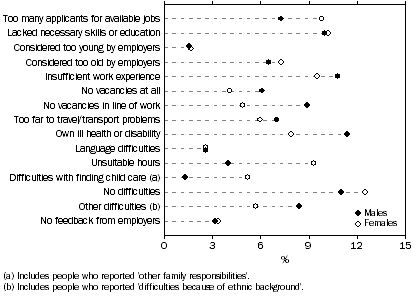
The main difficulties in finding work most commonly reported by unemployed men were 'own ill health or disability' and 'insufficient work experience' (each 11%) and 'lacked necessary skills or education' (10%). In comparison, 'lacked necessary skills or education', 'too many applicants for available jobs' and 'insufficient work experience' were the main difficulties most commonly reported by unemployed women (accounting for around 10% each). About 9% of unemployed women reported that their main difficulty in finding work was 'unsuitable hours' compared to 4% of unemployed men. 'Difficulties with finding child care and other family responsibilities' was reported as the main difficulty by 5% of unemployed women compared to just over 1% of unemployed men.
All steps taken to find work
The most common steps taken to find work reported by unemployed people in July 2007 were 'wrote, phoned or applied in person to an employer for work' (84%) and 'looked at advertisements for jobs in a newspaper' (82%). Other steps commonly taken to find work included 'looked at advertisements on the Internet' (66%) and 'answered an advertisement for a job in a newspaper' (59%).
Unemployed persons, Selected steps taken to find work(a) - July 2004 to July 2007 |
|
 | July 2004 | July 2005 | July 2006 | July 2007 |
 | 000 | % | 000 | % | 000 | % | 000 | % |
|
| Unemployed persons | 528.2 | 100.0 | 484.8 | 100.0 | 462.0 | 100.0 | 414.2 | 100.0 |
| Wrote, phoned or applied in person to an employer for work | 455.1 | 86.2 | 420.9 | 86.8 | 405.7 | 87.8 | 347.5 | 83.9 |
| Answered an advertisement for a job in a newspaper | 346.4 | 65.6 | 303.2 | 62.5 | 286.5 | 62.0 | 242.3 | 58.5 |
| Answered an advertisement for a job on the Internet | 195.0 | 36.9 | 188.0 | 38.8 | 204.8 | 44.3 | 202.4 | 48.9 |
| Answered an advertisement for a job on Centrelink touchscreens | 135.6 | 25.7 | 110.6 | 22.8 | 96.6 | 20.9 | 73.3 | 17.7 |
| Contacted friends or relatives | 239.7 | 45.4 | 217.4 | 44.8 | 230.8 | 50.0 | 190.7 | 46.0 |
| Registered with a Job Network employment agency | 277.9 | 52.6 | 235.5 | 48.6 | 240.6 | 52.1 | 202.6 | 48.9 |
| Checked with a Job Network employment agency | 253.6 | 48.0 | 224.7 | 46.4 | 222.0 | 48.0 | 186.1 | 44.9 |
| Looked at advertisements for jobs in a newspaper | 461.0 | 87.3 | 413.1 | 85.2 | 395.0 | 85.5 | 337.8 | 81.6 |
| Looked at advertisements for jobs on the Internet | 293.8 | 55.6 | 271.7 | 56.0 | 292.2 | 63.3 | 271.4 | 65.5 |
| Looked at advertisements for jobs on Centrelink touchscreens | 237.1 | 44.9 | 197.5 | 40.7 | 176.1 | 38.1 | 129.3 | 31.2 |
| Registered with Centrelink as a job seeker | 294.9 | 55.8 | 261.4 | 53.9 | 249.8 | 54.1 | 201.6 | 48.7 |
|
| (a) Refers to all steps taken to find work, therefore people may appear in more than category. |
From July 2004 to July 2007 there was a large increase in the percentage of unemployed people who reported using the Internet to find work. Fifty-six percent of unemployed people in July 2004 reported that they 'looked at advertisements for jobs on the Internet', which increased over time to 66% in July 2007. Over one third (37%) of unemployed people in July 2004 reported that they 'answered an advertisement for a job on the Internet'. This increased to 49% in July 2007, representing the largest percentage point increase of all the steps taken to find work by unemployed people from July 2004 to July 2007.
From July 2004 to July 2007 the percentage of unemployed people who reported having used Centrelink to find work decreased. The largest percentage point decrease was in those who reported that they 'looked at advertisements for job on Centrelink touchscreens' (45% in 2004 and 31% in 2007).
Larger proportions of long-term unemployed people used Centrelink or a Job Network employment agency compared to short-term unemployed people.
The largest percentage point difference in the steps taken to find work for the long-term unemployed compared to less the short-term unemployed were:
- 'Registered with Centrelink as a job seeker' (69% and 44% respectively)
- 'Looked at advertisements for jobs on Centrelink touchscreens (47% and 28% respectively)
- 'Answered an advertisement for a job on Centrelink touchscreens (30% and 15% respectively)
- 'Registered with a Job Network employment agency' (64% and 45% respectively)
- 'Checked with a Job Network employment agency' (59% and 42% respectively).
Unemployed persons, All steps taken to find work(a)
- By duration of current period of unemployment
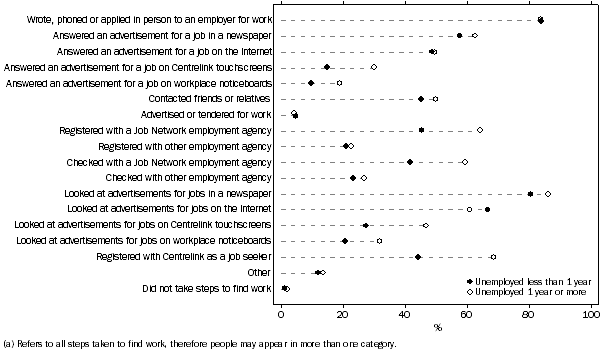
Preferred to work more hours
Unemployed Persons, Age group (years)
- By preferred number of hours(a)(b)
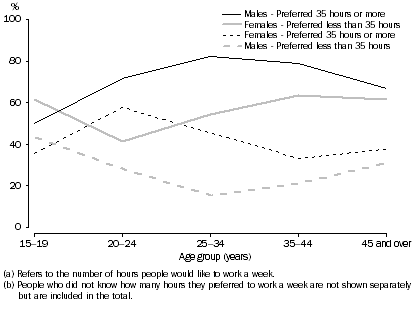
Generally, unemployed men preferred to work more hours than unemployed women. In July 2007, 69% of men reported that they preferred to work 35 hours or more, compared to 41% of women.
Unemployed men aged 25-34 years were the most likely to prefer 35 hours or more of work (82%) while for those aged 15-19 half (50%) preferred to work for 35 hours or more.
In contrast, 20-24 year old women were most likely of all unemployed women to want 35 hours or more of work (58%). For all other women, less than half in each age group preferred to work 35 hours or more.
Duration of unemployment
Less than one-fifth (19%) of unemployed people had been unemployed for 12 months or more. There was little difference in the duration of unemployment for males and females. Of those unemployed people who were without a non-school qualification, 20% had been unemployed for one year or more. In comparison, 17% of unemployed people who had a non-school qualification had been unemployed for one year or more. However, differences are more apparent when looking at the level of non-school qualification. About 13% of unemployed people with an Advanced Diploma or above had been unemployed for one year or more, compared with 21% of unemployed people with a Certificate IV or below.
Older unemployed
In July 2007 there were 99,600 unemployed people aged 45 years and over. Three-quarters (76%) of these were looking for full-time work. The most common main difficulty in finding work reported by this age group was 'considered too old by employers' (24%). For those aged 45 years and over who were unemployed for 12 months or more, 30% reported this as their main difficulty.
Younger unemployed
In July 2007 there were 91,800 unemployed people aged 15-19 years old. Of these, 51% were looking for full-time work. The main difficulty (14%) in finding work reported by this age group was 'insufficient work experience'. There were 19% who reported no difficulties at all, 56% of whom had been unemployed for less than four weeks.
In comparison, 67,000 of unemployed people were aged 20-24 years. Of these, 79% were looking for full-time work and 19% reported their main difficulty in finding work was 'insufficient work experience'.
EMPLOYED PEOPLE WHO STARTED THEIR CURRENT JOB IN THE PREVIOUS 12 MONTHS
Characteristics of current job
There were 1.6 million job starters at July 2007. More than one-third of these (35%) usually worked part-time hours. One-third of those who usually worked part-time (33%) preferred to work more hours.
The most common occupation groups for job starters were Professionals (17%), Clerical and administrative workers (16%), and Technicians and trade workers (14%). The most common occupation group for those aged:
- 15-19 years was Sales workers (32%)
- 25-34 years was Professionals (25%)
- 55 years and over were Managers, Professionals and Clerical and administrative workers (17% each).
Duration of looking for work
Over half (57%) of the job starters looked for work for less than one year before being offered that job or starting that business. Of those who looked for work for less than one year, 62% had looked for less than 8 weeks before commencing their current job.
About 40% of job starters had not been looking for work at all prior to commencing their current job. Only 4% of job starters had been looking for work for one year or more.
Job starters, Duration of looking for work before current job
- Age distribution
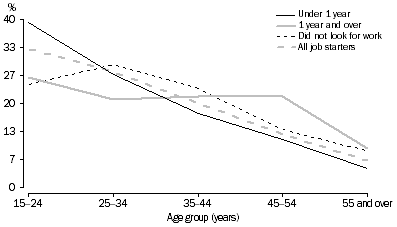
Just over three-fifths of job starters were aged less than 35 years (33% were aged 15-24 years and 28% were aged 25-34 years). This partly reflects the transition of younger people from education into work and may also reflect the greater job mobility of younger people. In contrast, only one-fifth were aged 45 years or older (13% were aged 45-54 years and 6% were aged 55 years and over).
People aged 45-54 years represented just 13% of all job starters at July 2007, but made up 22% of those job starters who had looked for work for more than one year. In contrast, while those aged 15-24 years represented 33% of all job starters, they made up 26% of job starters who had looked for work for one year or more.
Young job starters aged 15-24 years formed the largest group of those who had been looking for work for under a year (39%), yet represented 33% of all job starters.
Job starters aged 25-34 years formed the largest group of those who did not look for work before their current job (29%).
EMPLOYEES (EXCLUDING OMIES)
Of the 1.6 million job starters at July 2007, 89% were employees (excluding owner managers of incorporated enterprises (OMIEs)), and 11% were owner managers or contributing family workers.
Over half (56%) of those employees (excluding OMIEs), had changed their employer to start their current job, 33% were out of work prior to starting their current job and 11% stated that their current job was the first job they had ever held. Most (89%) employees (excluding OMIEs) who started their current job in the previous 12 months had worked before. Under half (41%) of employees (excluding OMIEs) who started their current job in the previous 12 months to July 2007 did not have paid leave entitlements (a proxy for casual 'employment').
All steps taken to attain a job
About two-thirds of employees (excluding OMIEs) (67%) who were out of work prior to starting their current job reported that they 'wrote, phoned or applied in person to an employer for work'. Over half (57%) of employees (excluding OMIEs) who had changed their employer to start their current job, also reported that they took this step to attain a job.
Employees (excluding OMIEs) who started their current job in the previous 12 months, Selected steps taken to attain a job(a)(b)
- By whether had worked before(c)
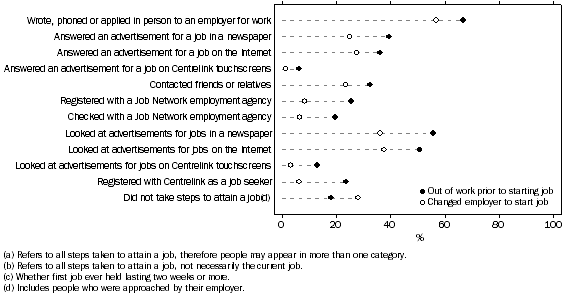
The other common steps taken to attain a job reported by people who were out of work prior to starting a job, and by people who changed their employer to start their current job were:
- 'looked at advertisements for jobs in a newspaper' (56% and 36% respectively)
- 'looked at advertisements for jobs on the Internet' (51% and 38% respectively)
- 'answered an advertisement for a job in a newspaper' (39% and 25% respectively)
- 'answered an advertisement for a job on the Internet' (36% and 27% respectively).
Employees (excluding OMIEs) who started their current job in the previous 12 months, Selected steps taken to attain a job(a)(b) - July 2004 to July 2007 |
|
 | 2004 | 2005 | 2006 | 2007 |
 | '000 | % | '000 | % | '000 | % | '000 | % |
|
Employees (excluding OMIEs) who started their current job
in the previous 12 months | 1 351.4 | 100.0 | 1 286.1 | 100.0 | 1 329.1 | 100.0 | 1 433.0 | 100.0 |
| Wrote, phoned or applied in person to an employer for work | 781.6 | 57.8 | 788.1 | 61.3 | 787.4 | 59.2 | 863.1 | 60.2 |
| Answered an advertisement for a job in a newspaper | 433.0 | 32.0 | 426.7 | 33.2 | 426.7 | 32.1 | 415.7 | 29.0 |
| Answered an advertisement for a job on the Internet | 275.9 | 20.4 | 316.8 | 24.6 | 380.0 | 28.6 | 431.0 | 30.1 |
| Answered an advertisement for a job on Centrelink touchscreens | 82.4 | 6.1 | 59.1 | 4.6 | 51.0 | 3.8 | 46.6 | 3.3 |
| Contacted friends or relatives | 346.5 | 25.6 | 328.6 | 25.6 | 371.3 | 27.9 | 393.9 | 27.5 |
| Registered with a Job Network employment agency | 214.8 | 15.9 | 191.5 | 14.9 | 207.1 | 15.6 | 205.5 | 14.3 |
| Looked at advertisements for jobs in a newspaper | 594.0 | 44.0 | 570.2 | 44.3 | 594.7 | 44.7 | 602.7 | 42.1 |
| Looked at advertisements for jobs on the Internet | 416.3 | 30.8 | 465.5 | 36.2 | 529.8 | 39.9 | 598.7 | 41.8 |
| Looked at advertisements for jobs on Centrelink touchsceens | 150.9 | 11.2 | 111.8 | 8.7 | 107.6 | 8.1 | 97.2 | 6.8 |
| Registered with Centrelink as a job seeker | 209.6 | 15.5 | 180.0 | 14.0 | 172.5 | 13.0 | 178.3 | 12.4 |
| Did not take steps to attain a job(c) | 369.4 | 27.3 | 323.9 | 25.2 | 333.8 | 25.1 | 342.2 | 23.9 |
|
| (a) Refers to all steps taken to attain a job, therefore people may appear in more than one category. |
| (b) Refers to all steps taken to attain a job, not necessarily the current job. |
| (c) Includes people who were approached by their employer. |
From July 2004 to July 2007 there was a large increase in the percentage of employees (excluding OMIEs) who reported using the Internet to attain their current job in the previous 12 months. In July 2004, 31% of employees (excluding OMIEs) who started their current job in the previous 12 months 'looked for advertisements for jobs on the Internet' and this had increased to 42% in July 2007. This represents the largest percentage point increase in frequency, from July 2004 to July 2007, of all the steps taken by employed people to attain their current job in the previous 12 months. The proportion of employees (excluding OMIEs) who started their current job in the previous 12 months and reported that they 'answered an advertisement for a job on the Internet' increased over time from 20% in July 2004 to 30% in July 2007.
 Print Page
Print Page
 Print All
Print All